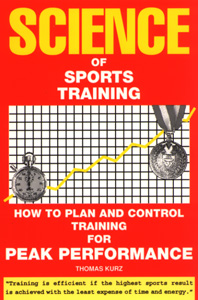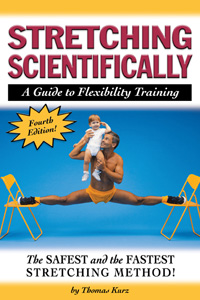by Thomas Kurz
For training to be effective and beneficial in the long run and in every respect (reliable skills, no chronic injuries, good health, and general fitness), it takes specialized knowledge. When that knowledge is missing the training becomes ineffective, even counterproductive and often injurious. In this article I answer some e-mail questions on training that prove it.
Question: I have been through many martial arts books and Web sites, and they always glance over the topic of stretching. They state how crucial it is, but they never tell you a straightforward, scientific method that actually works progressively. They seem to prefer the trial-and-error, hope-for-the-best method. I wonder why that is?
Answer: This is not a matter of preference but of not knowing any better—their authors do not have the training in anatomy and physiology and in the methods of sports training. They have not even bothered to read Stretching Scientifically where all the knowledge of stretching relevant to martial arts is condensed. It seems they think that because they are good enough engineers, bookkeepers, sales clerks, or carpenters and have passed rank tests in a martial art, they are good enough to advise on physical training or to conduct it.
Question: Traditional martial arts training seems to be just the opposite of what we martial artists need, with instructors insisting on prestretching for better kicks during the session, and encouraging bouncing in stretching. Why do those instructors do that?
Answer: Same as above, plus these instructors are not very observant, lack ability to think critically, and are not very inquisitive. If they were paying attention to their bodies and watched their students, they would notice that after a strenuous static stretch it is dangerous to kick all out. If they could think critically, they would question the idea of having to spend several minutes on preparing a weapon (a high kick) before being able to use it—especially if they were trying to develop habits of using high kicks in fighting. If they were inquisitive, they would search for ways of making all their weapons (for example, fists and legs) equally accessible and reliable.
As for their maintaining that static stretching before the workout prevents injuries—it has no basis in reality. The majority of research studies show static stretches before working out to be detrimental or of no benefit for injury prevention (Shrier 2000). Pre-exercise static stretching does not prevent soreness, tenderness, or the force loss that follows eccentric exercise (Johansson et al. 1999). (A full list of references is in the fourth edition of my book Stretching Scientifically: A Guide to Flexibility Training.
Question: I am using the methodologies you have put together in Science of Sports Training and have found them to be the most precise and useful in my 15 years as a trainer and 23 years as a martial artist. I need to know how “little” strength I can get away with when training martial arts competitors. I myself increased my squat by 100 lb. yet saw no real gains in applied power. I have a student who weighs 120 lb., never squats more than his body weight, and has kicked me off my feet (190 lb.). Regarding one of your protocols: In your text [Science of Sports Training on page 156] you make reference to optimal strength for athletes based on the strengths of the best athletes per weight class per sport. I however have no access to these figures. I would like to obtain the figures of optimal strength for all the weight classes and all the lifts for both striking and grappling arts. References you have to a site or text(s) would be appreciated. I want this info so that I can spend more time working on different skills with as little time as needed to be the best, for myself and my students.
Answer: Your lighter student can kick you off your feet because explosive power depends on how quickly one can generate force and not so much on one’s maximal force (maximal strength). In Science of Sports Training on pages 156–161 I explain when increasing maximal strength helps with increasing explosiveness, when it does not, and what to do when it does not.
You seem to have stopped reading at the middle of page 156 but later on the same page and on the pages that follow (157–161) you will see the answer to your question on power and solutions to your problem. None of the solutions requires comparing your strength to that of other athletes—just knowing what percentage of your body weight you lift and observing yourself! As you read keep in mind that a kick is like a jump—except someone else is supposed to fly away. If in addition to all that information you want specific exercises for improving power or explosiveness of your kicks, then see chapter 7 in Explosive Power and Jumping Ability for All Sports for progressions of plyometric exercises for combat sports—among them those for kicks. Consider also adding to your program methods of developing explosive power through fast squats and half-squats. These methods are described in chapter 1 of Explosive Power and Jumping Ability for All Sports.
Ponder these two quotes from past issues of Stadion News that apply to directing all aspects of sports training:
1. “Those coaches that carefully watch the performance of their athletes in contests and in training know, without having to study papers, what exercises and how much of them to do. All it takes is reacting to the signs—how athletes act, perform, and feel.” (Of course, to understand the signs and to know how to react to them, it takes a coach—someone with knowledge of exercise physiology, biomechanics, and methods of sports training. The more you know the more you notice and the more you are able to make better sense of what you see.)
2. “Pay attention to your body to decide what exercises to do and which to drop. For example, if your feet hurt when practicing jumping kicks or kicking a heavy bag, then kick less and do more general strength exercises for your feet (to strengthen their arches).”
The statement you refer to, about optimal strength on page 156 of Science of Sports Training, pertains mainly to track and field (see examples given on that page) and weightlifting, sports in which athletes of a given specialty (of track and field) or weight class (in weightlifting) are build very similarly to each other because they are selected and trained to do the same thing and in the same way. In this situation knowledge how one athlete compares to others in standard strength exercises, body weight, and body dimensions is important for planning training. In sports such as combat sports or team games, in which activity is nonstandard and results are not measured in weight or distance, the knowledge of other athletes’ strength measurements is not so important.
If you still want to you can get the information on maximal strength measurements of athletes in combat sports from strength and conditioning or exercise science periodicals. Search the Web for archives of periodicals, research papers, and other publications on sports training.
If you find data on strength of some muscle groups but not all, you can use the approximations of normal (or desirable) ratios of strength to project the missing data. Below are examples of those ratios measured in slow concentric movements (Wathen 1994):
Shoulder external-to-internal rotation—2:3
Shoulder flexion-to-extension—2:3
Shoulder adduction-to-abduction—2:1
Elbow flexion-to-extension—1:1
Trunk (lumbar spine) flexion-to-extension—1:1
Hip flexion-to-extension—1:1
Knee flexion-to-extension—2:3
Ankle dorsiflexion-to-plantar flexion—1:3
Ankle eversion-to-inversion—1:1
Coaches in the former Eastern Bloc had access to tests results and measurements from virtually all their countries’ athletes because most important training and testing data were gathered by respective sports associations and physical education and sports research institutes. Gathering, arranging, and making such data available to coaches is one of the most important jobs of sports associations.
This article is based on the books Explosive Power and Jumping Ability for All Sports, Science of Sports Training and Stretching Scientifically and the video Secrets of Stretching. Get the books and the video now and have all of the info—not just the crumbs! Order now!
References
Kurz, T. 2001. Science of Sports Training: How to Plan and Control Training for Peak Performance. Island Pond, VT: Stadion Publishing Company, Inc.
Kurz, T. 1990. Secrets of Stretching: Exercises for the Lower Body. Island Pond, VT: Stadion Publishing Company, Inc.
Kurz, T. 2003. Stretching Scientifically: A Guide to Flexibility Training. Island Pond, VT: Stadion Publishing Company, Inc.
Starzynski, T., and H. Sozanski. 1999. Explosive Power and Jumping Ability for All Sports: Atlas of Exercises. Island Pond, VT: Stadion Publishing Co., Inc.
Wathen, D. 1994. Muscle Balance. In Essentials of Strength Training and Conditioning, ed. T. R. Baechle, pp. 424–30. Champaign, IL: Human Kinetics (http://www.humankinetics.com).
If you have any questions on training you can post them at Stadion’s Sports and Martial Arts Training Discussion Forum



